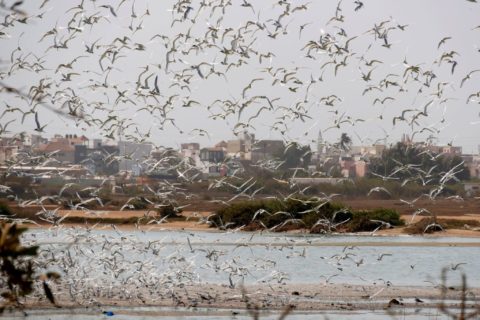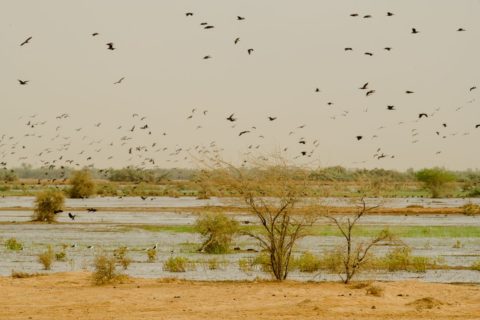This article was originally published in The Standard newspaper (Kenya)
-By Julie Mulonga, Director – Wetlands International Eastern Africa and Dr Kariuki Ndang’ang’a, Africa Regional Director, BirdLife International
A year ago, Kenyans were awestruck by a bird that flew some 7,000 kilometres from Poland to Nandi County in the Rift Valley. The tagged bird was part of a flock of White Storks that had crossed continents and cultures, only to get electrocuted after it hit power lines. In 2020, an Osprey flew more than 6,948 kilometres from Finland to Siaya, where it was trapped by fishing nets, before being rescued.
Presently, a tagged Greater Sand Plover christened ‘Boaz’ embarked on an epic journey from Tanga in Tanzania’s northern coast, starting out towards Oman on March 25, and flew 100 hours non-stop covering 3,800 kilometres. He is at the Caspian Sea shore in Iran after resting briefly in Xinjiang, China following a perilous feat of crossing the chilly, rustic Himalayas Mountains.
These journeys exemplify bird migration, one of the most amazing natural phenomena in the world.

Sandwich terns by Jaime Garcia Moreno
It is estimated that one in five of all our world’s bird species migrate. These feathery species travel thousands of kilometres on specific routes known as flyways, across continents in search of suitable feeding, breeding and resting grounds. There are eight flyways globally, one of which is the African-Eurasian Flyway – covering Africa, Europe, and parts of Asia along which more than two billion birds migrate annually. Migratory birds provide immeasurable value to the environment, from pollination, controlling pests to food sources for other wildlife species. Further, migratory birds contribute billions of dollars every year to the tourism sector in many countries around the world including Kenya through birdwatching.
Birds also play a critical ecological role and are one of the best indicator species of our planet’s health. Severe decline in bird numbers is an early and grim warning about current and future threats that biodiversity and people will face.
Migratory birds rely on water and habitats including grasslands, forests, and wetlands for migration, breeding and resting. However, various factors including intensive agriculture, pollution, climate change, among others, are threatening these important ecosystems.
The case of declining wetlands is one of grave concern. Across Africa, rivers, lakes, floodplains, swamps and marshes, inland deltas and other wetlands play a crucial role in ensuring food security for people and are repositories of biodiversity and absorb huge amounts of carbon. They support a complex and delicate web of life and are vital stopover points for migratory birds, providing shelter, food, water, and nurturing grounds for their offspring. Without these ecosystems, many migratory bird populations would decline, and some species could even face extinction.
Since the 1700s, wetlands have been degraded, with the world losing about 90 per cent of these critical ecosystems, negatively impacting species including birds. Kenya has been facing climate change impacts in the past decade and is now recovering from prolonged and devastating drought after rains failed last year, with some areas lacking rainfall for five successive seasons. This affected key wetlands such as Lake Ol Bolossat which hosts various bird species including the endangered Grey Crowned Crane, forcing them to move to other habitats. Another good example is in the Sahel region, where Lake Chad – once Africa’s largest water reservoir in the region, covering about 26,000 square kilometres in the 1960s – has shrunk by more than 90% to less than 1500 square kilometres today, negatively impacting communities and biodiversity.

Pix by Lars Soerink
Every year, the globe celebrates World Migratory Bird Day in May and October to raise awareness about these feathery species. This year’s theme aptly recognises that water sustains bird life and will be commemorated on 13 May and October 14. Consequently, it is essential that these vital habitats and the services they provide are preserved and those degraded restored.
Collaboration between the public and private sectors is key to strengthening protection of these critical sites for migratory birds. A good example of this is in Asia, where BirdLife in collaboration with the Asian Development Bank (ADB) and the East Asian Australasian Flyway Partnership Secretariat (EAAFP), launched the $ 3 billion Regional Flyway Initiative (RFI) in 2021. The initiative aims at scaling up protection, restoration, and sustainable management of more than 50 key wetlands sites along the East Asian Australasian Flyway, stretching from Siberia and Alaska to New Zealand and Australia. These wetlands also serve as important re-fuelling and resting sites for millions of migratory birds while provide sustainable economic livelihoods for thousands of communities including through agriculture, fisheries, and eco-tourism among others.
Wise use models can be replicated across flyways with immense benefits for nature and people. This will require identification of nationally relevant solutions, working with local communities, policy makers, decision makers, and civil society groups among others. Our world is an intricate web of life. Migratory birds and wetlands mirror our story as humans, and their fate is likely to point to our eventual fate if we do not take appropriate action now. It is therefore imperative that we redouble efforts to safeguard migratory birds and wetlands for posterity.
Lead image of a Saddle-billed Stork: Diego Delso


Leave a comment